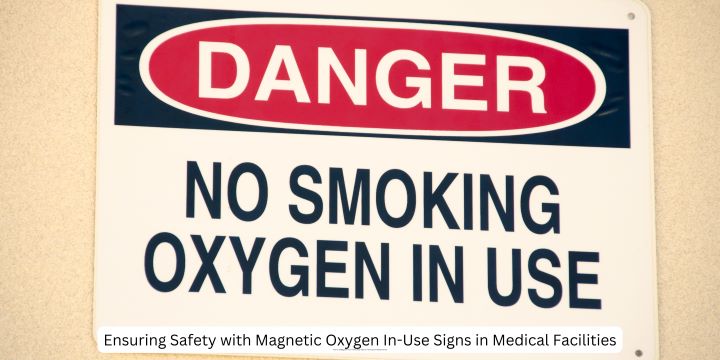Key Takeaways
- The role of magnetic oxygen in use signs in enhancing safety in medical environments.
- Understanding the importance of clear signage for oxygen use and storage areas.
- Practical tips on effective placement and maintenance of these signs.
The Crucial Role of Safety Signs in Healthcare
In medical environments, safety is paramount. One of the critical components in maintaining high safety standards is the use of clear and effective signage. Specifically, a well-placed oxygen in use sign plays a crucial role in communicating essential safety information to both staff and visitors.
Magnetic oxygen in-use signs are indispensable in these high-risk areas. These signs serve as a vital alert system, notifying staff and visitors about the ongoing oxygen usage and the necessary precautions to be observed. This simple measure can significantly reduce the incidence of accidents related to oxygen use by ensuring everyone is informed and aware of the potential hazards associated with oxygen tanks and lines.
Understanding Magnetic Oxygen In Use Signs
Magnetic oxygen-in-use signs indicate areas where oxygen is currently being used or stored. These signs are crucial in preventing accidents and ensuring that staff and visitors are aware of the potential hazards in specific areas of a healthcare facility. According to an article by Medical News Today on understanding hospital safety protocols, proper signage is a key aspect of maintaining a safe hospital environment.
In addition to providing clear warnings, these signs also help in guiding emergency responders during critical situations, ensuring they are quickly aware of where oxygen supplies are located and maintained, which is vital for both regular operations and emergency procedures.
Why Magnetic Signs Are Effective
Magnetic signs are particularly effective in medical settings for several compelling reasons:
- Flexibility: Magnetic signs can be placed and removed with ease, allowing for quick updates and changes as per the evolving needs of the medical environment. This makes them incredibly adaptable to dynamic settings such as hospitals and clinics.
- Non-Intrusive: Because they leave no residue, magnetic signs do not compromise cleanliness and hygiene standards, which are critically important in healthcare facilities. They can be replaced or repositioned without necessitating additional cleaning.
- Durability: Typically, these signs are constructed from sturdy materials that are resistant to normal wear and tear. This durability ensures that the signs remain legible and effective for longer periods, minimizing the need for frequent replacements.
This combination of flexibility, non-intrusive application, and durability makes magnetic signs an ideal choice for maintaining safety standards within healthcare settings, where conditions can change rapidly, and the highest levels of hygiene must be preserved.
Implementing Signage: Best Practices
Effective implementation of oxygen safety signs involves strategic placement and regular maintenance. Here are some practical tips that can help maximize their effectiveness:
- Placement: Ensure signs are placed at eye level near storage areas and entrances to rooms where oxygen is used. Proper placement is critical to ensure that the signs catch the attention of anyone entering the area, thus providing an immediate reminder of the potential hazards.
- Visibility: Use bright colors and clear fonts to ensure the signage is easily readable from a distance. Since healthcare settings can be busy with frequent foot traffic, the signs must stand out to be effective.
- Maintenance: Regularly check signs for wear and tear and replace them as necessary to maintain visibility and clarity. Over time, signs can become dirty or damaged, which can reduce their effectiveness. Periodic checks ensure that they always remain in good condition.
Healthcare institutions may make sure that their signage not only works well but also promotes a culture of safety and awareness by adhering to certain best practices.
The Broader Impact of Proper Signage
Proper signage goes beyond immediate safety. It fosters an environment of awareness and diligence among both staff and visitors. A healthcare facility’s overall safety standards can be raised and the danger of accidents can be greatly decreased with the help of clear and efficient signs. According to a study by the National Institutes of Health, well-implemented safety practices can enhance patient outcomes and staff efficiency.
Additionally, proper signage can help reduce the stress and confusion often experienced in busy medical environments. By providing clear directions and warnings, signs can help staff navigate their tasks more efficiently and allow visitors to move through the facility with greater confidence.
Real-Life Examples of Effective Signage
Consider a busy hospital in a metropolitan area. Effective use of magnetic oxygen-in-use signs in this setting helps streamline operations and ensure that any changes in oxygen storage or use are quickly communicated to all relevant parties. This reduces the likelihood of mishaps and guarantees that a high level of safety is upheld.
For instance, in an emergency situation where rapid response is crucial, the presence of clear and unambiguous signage can save precious time by quickly informing medical staff and emergency responders of the oxygen supplies’ location. In urgent cases, having this instant access could be the difference between life and death.
Conclusion: Commitment to Safety
Ultimately, the implementation of magnetic oxygen in-use signs is a testament to a facility’s commitment to safety. By following best practices and ensuring that these signs are visible and well-maintained, healthcare institutions can provide a safer environment for both patients and staff. Thus, investing in high-quality signage is not just a regulatory requirement but a crucial aspect of healthcare management.
Furthermore, the broader cultural shift towards safety and precaution encouraged by effective signage has far-reaching impacts on the overall efficiency and well-being within the healthcare setting. It’s about creating a safer, more organized, and more focused environment where the primary concern is the health and safety of everyone within the facility.



